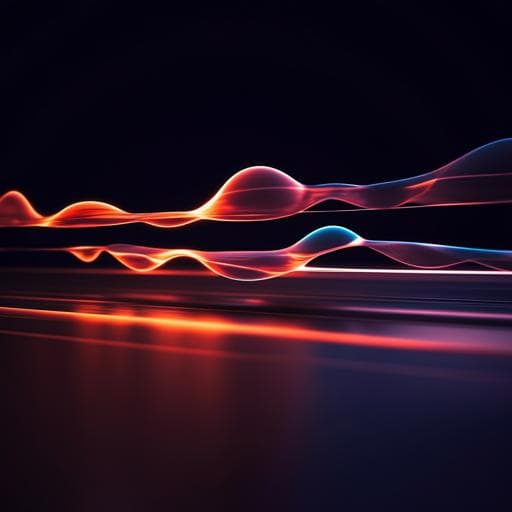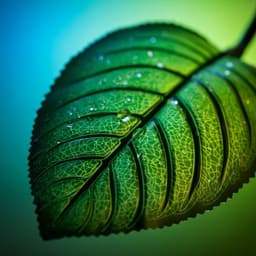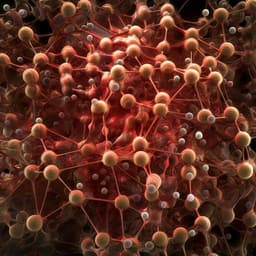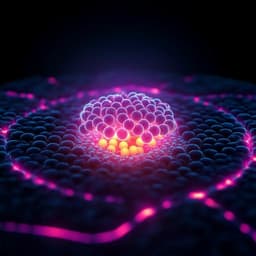
Engineering and Technology
Extremely fast electrochromic supercapacitors based on mesoporous WO₃ prepared by an evaporation-induced self-assembly
K. Kim, T. Y. Yun, et al.
Discover groundbreaking ultrafast electrochromic supercapacitors (ECSs) that promise rapid switching speeds and exceptional stability. Developed by Keon-Woo Kim and colleagues, these ECSs utilize amorphous mesoporous tungsten trioxide to potentially transform smart windows and portable energy displays.
~3 min • Beginner • English
Introduction
Electrochromic devices (ECDs), which control light transmittance through electrochemical redox reactions, have been widely used in electrochemical reflective displays or smart windows for energy efficient buildings. Recently, the functionality of ECDs has been extended to include energy storage, which is referred to as electrochromic supercapacitors (ECSs). ECSs can not only change optical properties but also store the energy supplied for coloration, with color intensity reflecting real-time energy state.
A key parameter for high-performance ECSs is the electrochromic chromophore. Transition metal oxides such as tungsten trioxide (WO₃) offer superior electrochemical properties, large optical modulation, and high coloration efficiency, and have been widely used in ECDs and ECSs. Prior WO₃-film ECSs prepared by thermal evaporation formed dense layers with low Li⁺ diffusivity and long diffusion paths, leading to slow switching and limited optical modulation. Alternative WO₃ nanostructures (nanosheets, nanoparticles, macroporous films) improved some aspects but still lacked sufficient interfacial area and retained relatively long ion diffusion distances for ultrafast dynamics required in displays. Mesoporous structures with fully interconnected small pores (2–50 nm) are ideal to enable ultrafast response.
Hard templating methods can form mesoporous structures but require multistep processing and offer limited pore-size tunability. In contrast, evaporation-induced self-assembly (EISA), which combines sol–gel chemistry with amphiphile self-assembly, can produce mesoporous metal oxides with tunable pore sizes and is compatible with versatile solution processes (spray-, spin-, dip-coating, printing).
Here, ultrafast-response ECSs are realized using amorphous mesoporous WO₃ films prepared by EISA. Compared to compact-WO₃ films, mesoporous WO₃ devices show large optical modulation (ΔT = 76%), sub-1 s switching (τc = 0.8 s, τb = 0.4 s), and excellent stability under fast switching. Combining EISA with printing (PEISA) enables patterned mesoporous WO₃ for electrochromic supercapacitor displays (ECSDs) that store energy used for coloration and can power other devices (e.g., LEDs), highlighting potential for next-generation smart electrochemical components.
Literature Review
The paper reviews prior work on ECDs and ECSs, highlighting that WO₃ is a leading EC material due to its large optical modulation and high coloration efficiency. Previous ECSs using WO₃ films formed by thermal evaporation suffered from dense film morphology, resulting in low Li⁺ diffusivity, long diffusion distances, slow switching, and limited optical modulation. Alternative WO₃ nanostructures (nanosheets, nanoparticles, macroporous films) improved performance but still lacked sufficient interfacial area and retained relatively long ion diffusion distances for ultrafast dynamics needed in display applications. Mesoporous architectures with fully interconnected pores (2–50 nm) are identified as ideal to maximize interfacial area and minimize ion diffusion length. Hard templating approaches to mesoporosity require multistep fabrication and offer limited pore-size control, whereas EISA enables tunable mesoporous metal oxides via solution processing and can be integrated with coating/printing techniques.
Methodology
Mesoporous WO₃ film fabrication via EISA: A mixed solution was prepared with tetrahydrofuran (THF) containing polystyrene-block-poly(ethylene oxide) (PS19k-b-PEO6.5k) and ethanol containing WCl₆ as the WO₃ precursor. This solution was spin-coated onto FTO-coated glass to form an inorganic–organic composite film. During solvent evaporation, THF evaporated first, and PS-b-PEO formed spherical micelles with hydrophobic PS cores and PEO shells complexed with hydrolyzed tungsten species. The composite was calcined at 350 °C for 1 h, partially removing organics and converting the inorganic portion to WO₃, yielding an amorphous carbon/WO₃ mesoporous composite. Subsequent O₂ plasma treatment selectively removed amorphous carbon without inducing WO₃ crystallization, resulting in an amorphous mesoporous WO₃ film.
Structural/chemical characterization: SEM (top view and cross-section) confirmed mesoporous morphology with average pore diameter ~30 nm and film thickness ~250 nm. XPS W 4f peaks at 35.5 and 37.7 eV indicated W⁶⁺. XRD showed no distinct WO₃ peaks (amorphous), corroborated by HR-TEM (no lattice fringes) and SAED (amorphous halo). Nitrogen adsorption–desorption exhibited a Type-IV isotherm with SBET = 32.14 m²/g and BJH pore size centered at ~29.3 nm.
Device architecture: ECSs comprised an FTO|mesoporous WO₃ EC layer|liquid electrolyte (1 M LiClO₄ in propylene carbonate)|NiO ion-storage layer|ITO substrate. A comparison device used a compact WO₃ film prepared from WO₃ nanoparticles with similar thickness (~260 nm). NiO films were characterized by XRD, XPS, and SEM. Optical/electrochemical testing included UV–vis transmittance under applied voltages, in situ transmittance at 700 nm during switching, EIS (Nyquist analysis), cyclic voltammetry (200–1500 mV/s), and galvanostatic charge–discharge (various current densities). Areal capacitance was calculated from GCD discharges using C = IΔt/(SΔV).
Patterned EC displays: Printing-assisted EISA (PEISA) was used to pattern mesoporous WO₃ for electrochromic supercapacitor displays (ECSDs). Devices demonstrated visual state-of-charge indication and the ability to power external loads (e.g., LEDs).
Key Findings
- Mesoporous WO₃ ECS exhibited large optical modulation at 700 nm: ΔT ≈ 76% with sub-1 s switching (tc = 0.8 s coloration, tb = 0.4 s bleaching), outperforming compact WO₃ devices that required much longer times (tc ≈ 6.8 s, tb ≈ 9.2 s) to reach similar ΔT (~78% after long holds).
- Coloration efficiency: 682 cm²/C for mesoporous WO₃ vs 188 cm²/C for compact WO₃, indicating lower charge consumption for a given optical change.
- Surface area and porosity: Mesoporous WO₃ SBET = 32.14 m²/g with average pore diameter ~29.3 nm (BJH), versus compact WO₃ SBET = 6.4 m²/g.
- Electrical/ion transport: EIS showed mesoporous WO₃ ECS had lower contact and charge transfer resistances and a larger Warburg slope (lower ion diffusion resistance) than compact WO₃ ECS.
- Areal capacitance at low rate (0.02 mA/cm²): mesoporous WO₃ ECS 2.57 mF/cm²; compact WO₃ ECS 2.51 mF/cm². At high rate (1.0 mA/cm²), capacitance retention was 68% (mesoporous) vs 34% (compact).
- Ragone performance: Mesoporous WO₃ ECS achieved 15.8 Wh/kg at 0.2 kW/kg; retained 10.6 Wh/kg at 9.6 kW/kg, greatly exceeding compact WO₃ ECS (~4.9 Wh/kg at ~8.8 kW/kg).
- Cycling stability: Under fast optical switching (1 s coloration/5 s bleaching), mesoporous WO₃ ECS maintained 85.5% of initial optical modulation after 1000 cycles; compact WO₃ ECS dropped to 70.7%. During high-rate GCD (1.0 mA/cm²), mesoporous WO₃ ECS lost only 6.2% after 1000 cycles, while compact WO₃ ECS retained only 14% of its initial areal capacitance.
- Amorphous nature of mesoporous WO₃ confirmed by XRD/HR-TEM/SAED facilitates rapid ion insertion/extraction. In situ optical monitoring matched charge/discharge state, enabling direct visualization of stored energy.
- Patterned ECSDs via PEISA functioned as portable energy-storage displays whose color indicated state-of-charge, and stored energy could power LEDs.
Discussion
The mesoporous, fully interconnected pore network combined with an amorphous WO₃ framework significantly enhances electrolyte accessibility and shortens Li⁺ diffusion paths, yielding ultrafast electrochromic switching and improved high-rate capacitive behavior. EIS evidences reduced interfacial/contact and charge transfer resistances and lower ion diffusion resistance compared to compact films, explaining preserved CV shape at high scan rates and superior capacitance retention at high current density. The large surface area increases active sites for redox, boosting coloration efficiency and enabling substantial optical modulation within sub-second times. Stability under rapid cycling is improved, though some Li⁺ trapping still occurs; nonetheless, mesoporous WO₃ maintains optical and capacitive performance far better than compact WO₃. The direct correlation between optical transmittance and charge storage allows real-time visualization of state-of-charge, and PEISA patterning demonstrates practical ECSDs that both display and deliver stored energy, highlighting relevance for smart windows and portable reflective displays.
Conclusion
This work demonstrates ultrafast electrochromic supercapacitors using amorphous mesoporous WO₃ films fabricated by EISA. The devices achieve large optical modulation (≈76% at 700 nm), sub-1 s switching (0.8 s coloration, 0.4 s bleaching), high coloration efficiency (682 cm²/C), robust high-rate areal capacitance (2.57 mF/cm² at 0.02 mA/cm² with 68% retention at 1.0 mA/cm²), and excellent cycling stability (only 6.2% capacitance loss after 1000 high-rate cycles; 85.5% optical modulation retention after 1000 fast switching cycles). Superior performance arises from the amorphous mesoporous architecture that enhances ion/electron transport and active interfacial area. Combining EISA with printing (PEISA) enables patterned ECSDs that visualize and supply stored energy, suggesting strong potential for next-generation smart windows and portable electrochromic displays. Future work could further optimize pore architecture and integrate solid-state electrolytes for broader environmental robustness and device integration.
Limitations
While mesoporous WO₃ ECSs exhibit excellent stability, Li⁺ trapping over repeated cycles leads to reduced color intensity (presence of inactive Li-containing W and Ni species), indicating some long-term degradation of optical modulation. Performance was characterized in a specific liquid electrolyte (1 M LiClO₄ in propylene carbonate) and with specific film thicknesses; broader environmental/temperature stability and scalability aspects are not detailed in the provided text.
Related Publications
Explore these studies to deepen your understanding of the subject.







